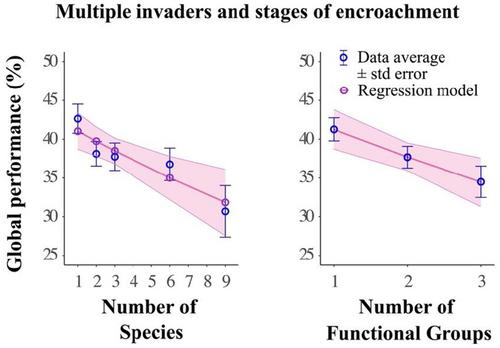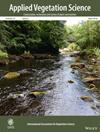Resistance against tree encroachment is driven by richness and identity of herbaceous resident speces
Abstract
Aims
Herbaceous plant cover can be used to inhibit tree encroachment in many managed and semi-natural grasslands. Ideally, herbaceous seed mixtures should reduce the establishment and growth of many invading tree species over several years. Theory predicts that invasion resistance can be maximized by both: (a) increasing the diversity (taxonomic and/or functional) of resident seed mixtures, and (b) including species that are especially efficient at blocking further colonizers. We established an experiment in a regularly mown old field within a deciduous forest region in southeastern Canada. Our overall goal was to examine the relative contribution of old field community composition and diversity (taxonomic and functional) to resistance against encroachment by two undesirable native tree species over time.
Location
Varennes, southern Québec, Canada (45°37′01.24″ N, 73°23′03.57″ W).
Methods
We tested our hypotheses by seeding experimental plots with different levels of taxonomic diversity (from one to nine species) and functional group richness (grasses, legumes, and forbs). Our herbaceous species comprised four native species and five introduced and naturalized species. We then seeded the plots with two model tree colonizers, Acer rubrum and Betula populifolia, during three consecutive years. We also transplanted seedlings of Acer and Betula to determine the effect of herbaceous diversity on post-emergence growth and seedling survival.
Results
Overall, herbaceous species identity (presence and absence) better predicted the resistance of resident herbaceous seed mixtures to tree encroachment than the other diversity measures assessed in our study. Fast-growing herbaceous species, such as Lolium, substantially inhibit resistance to woody encroachment in the first year. Achillea millefolium and Solidago canadensis were by far the most efficient in blocking tree seedling establishment and growth, particularly during the second and third years. These effects highlight the potential for a combination of fast-growing species, along with slower-growing but highly inhibitive species, as a way to limit tree encroachment in real field applications. Functional group richness was a poor predictor of tree encroachment. Species richness reduced tree encroachment, especially when considering a multidimensional tree encroachment index integrating all aspects of tree establishment and growth over the three years of our experiment.
Conclusions
Seeding highly inhibiting herbaceous species is the most efficient approach against specific tree invaders. However, it is difficult to implement in practice because it relies on a priori knowledge of the species’ inhibitory effects. In the absence of this knowledge, the taxonomic richness of seed mixtures should be increased to prevent tree encroachment.


 求助内容:
求助内容: 应助结果提醒方式:
应助结果提醒方式:


